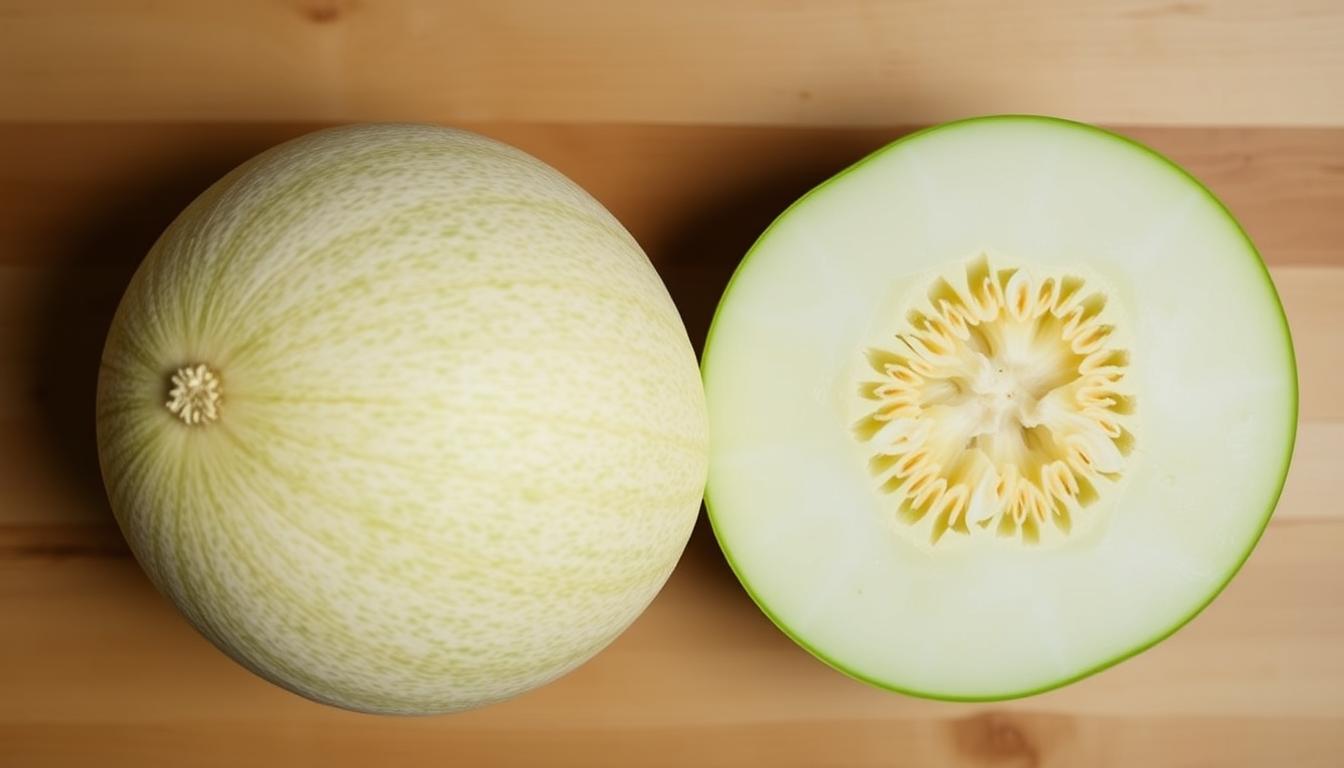Are you torn between choosing a casaba or honeydew melon for your next summer snack?
Both are refreshing and sweet, but they have distinct characteristics that set them apart. Melons are a staple in many cuisines, particularly during the warmer months, offering not just a burst of juicy flavor but also numerous health benefits due to their high vitamin content.
As members of the Cucurbitaceae family, melons are related to squash and cucumbers, and are botanically classified as a type of berry. Understanding the differences between casaba and honeydew melons can enhance your culinary experiences and dietary choices.
Key Takeaways
- Understand the physical and taste differences between casaba and honeydew melons.
- Learn about their nutritional content and health benefits.
- Discover the best ways to incorporate these melons into your diet.
- Identify the unique characteristics of each melon variety.
- Make informed choices for your recipe planning and dietary needs.
Understanding Casaba and Honeydew Melons
To understand the differences between Casaba and Honeydew melons, it’s essential to first grasp what each type of melon is. Both are popular for their unique flavors and textures, but they belong to different categories within the melon family.
What is a Casaba Melon?
Casaba melons are a type of winter melon known for their bright yellow, wrinkled exterior. They are characterized by their mild, slightly spicy flavor profile. Unlike many other melon varieties, Casaba melons don’t emit a strong aroma when ripe, making visual cues crucial for determining their ripeness. The skin color is the best indicator of ripeness, with ripe Casabas turning pale yellow and developing deep wrinkles that gather at the stem end.
Casaba melons are less common in mainstream grocery stores compared to other melon varieties. However, they are prized for their deliciously sweet and almost spicy taste. Their unique appearance and flavor make them a favorite among those who enjoy trying different types of melons.
What is a Honeydew Melon?
Honeydew melons are immediately recognizable by their smooth, pale green skin and light green flesh. They belong to the Cucumis melo L. Inodorus group and are known for their sweet flavor and refreshing texture. Honeydew melons are a summer staple and have a hard rind that allows them to last a long time. While they may not have as strong a fragrance as muskmelons, they can be equally sweet.
Honeydew melons are widely available and rank as one of America’s most popular melon varieties. Their smooth skin and sweet flesh make them a favorite in many households.
Melon Classification and Family
Both Casaba and Honeydew melons belong to the Cucurbitaceae family, which includes other popular fruits like watermelons, cucumbers, and various squash varieties. Understanding their botanical classification helps explain why these fruits share certain characteristics while maintaining their unique properties. Melons are related to cucumber and squash, and their classification within the Cucurbitaceae family highlights their shared evolutionary history.
The ancient origins of these melons, with cultivation dating back thousands of years, underscore their importance in human history and cuisine. Both Casaba and Honeydew melons have been enjoyed across different civilizations, each bringing their unique flavor profiles to the table.
Physical Characteristics and Appearance
When it comes to distinguishing between casaba and honeydew melons, their physical characteristics play a crucial role. The appearance of these melons can provide valuable clues about their identity, quality, and ripeness.
Casaba Melon Appearance
Casaba melons are known for their distinctive bright yellow exterior, which is often described as football-shaped. The skin of a casaba melon features deep longitudinal furrows and wrinkles that intensify near the stem end. These melons tend to be slightly larger and more oblong compared to other varieties.
The flesh of a casaba melon is creamy white to pale green, with a firm texture that’s less juicy than many other melon varieties. The contrast between the yellow skin and the white interior is quite striking.
Honeydew Melon Appearance
Honeydew melons, on the other hand, present a smooth, pale green to white exterior with a waxy feel when ripe. Unlike casaba melons, honeydew melons lack the netted pattern found on cantaloupes and have a hard rind. The flesh of a honeydew melon is characteristic pale green, juicy, and tender, with a small central cavity containing seeds.
How to Tell Them Apart
So, how can you tell casaba and honeydew melons apart? One of the most obvious visual differences is their exterior – casaba’s deeply furrowed yellow skin versus honeydew’s smooth pale green rind. The color contrast between the rind and flesh differs significantly between the two varieties.
Here’s a summary of the key differences in a table format:
| Characteristics | Casaba Melon | Honeydew Melon |
|---|---|---|
| Exterior Color | Bright Yellow | Pale Green to White |
| Skin/Rind Texture | Deep furrows and wrinkles | Smooth and waxy |
| Flesh Color | Creamy White to Pale Green | Pale Green |
| Shape | Oblong, Football-shaped | Round |
By examining these physical characteristics, you can easily distinguish between casaba and honeydew melons. Both varieties have their unique features, making them stand out as distinct fruits.
Casaba Melon vs Honeydew: Taste and Texture Comparison
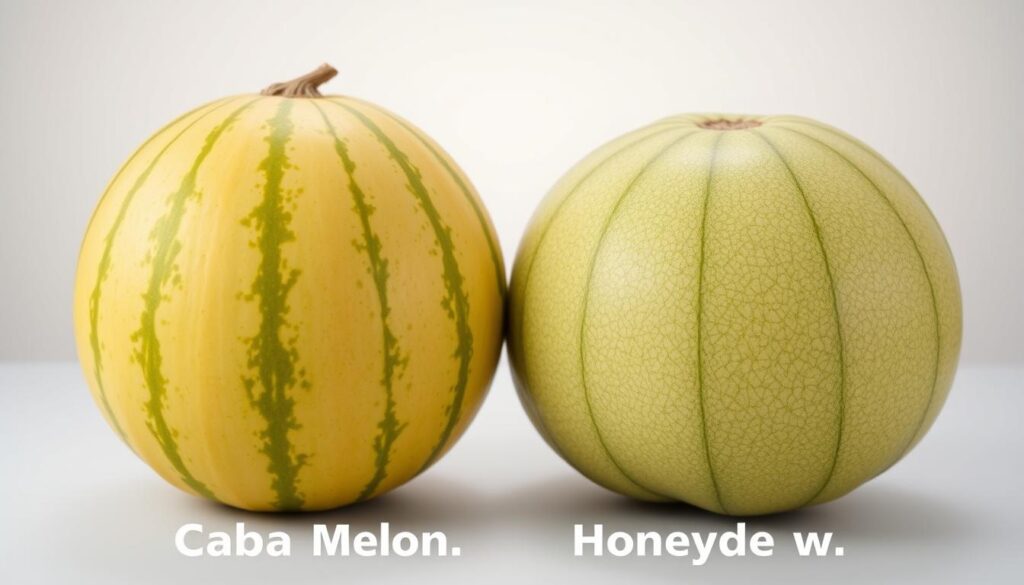
Casaba and honeydew melons, while both refreshing and sweet, exhibit distinct differences in their flavor and texture. The unique characteristics of each melon make them suitable for different culinary uses and personal preferences.
Casaba Melon Flavor Profile
Casaba melons offer a distinctive flavor profile that combines mild sweetness with subtle tanginess and sometimes a slightly spicy note. The flavor is often described as refreshing and delicate, with some noting a cucumber-like taste with honeyed undertones. Casaba’s tropical flavor pairs well with bright summer herbs like mint, cilantro, and basil in salads.
Honeydew Melon Flavor Profile
Honeydew melons deliver a clean, pronounced sweetness with floral notes that intensify as the fruit ripens fully. They are mildly sweet with a crisp and very juicy texture. Honeydew can be dressed with bright flavors like grated ginger and a squeeze of lemon to enhance its natural sweetness.
Texture Differences
The texture contrast between casaba and honeydew melons is significant. Casaba provides a firmer, less juicy flesh that holds its shape well when cut, making it ideal for salads and fruit arrangements. In contrast, honeydew offers a smoother, more succulent eating experience with its tender, juicy flesh that practically melts in your mouth.
The differences in texture and flavor between casaba and honeydew melons are not just about personal preference; they also affect how these melons perform in various culinary applications. Both melons develop their best flavors when allowed to ripen fully, though casaba will never achieve the same level of aromatic intensity as honeydew. Temperature also plays a role, with slightly chilled melons generally offering the most balanced taste experience.
Nutritional Comparison
Both Casaba Melon and Honeydew Melon are nutritious, but their nutritional profiles show some notable variations. Understanding these differences can help consumers make informed choices based on their dietary needs.
Caloric and Macronutrient Content
When comparing the caloric content of Casaba Melon and Honeydew Melon, it’s evident that Honeydew Melon provides slightly more energy, with 36 kcal per 100g serving compared to Casaba Melon’s 28 kcal per 100g serving. Casaba Melon stands out with its higher protein content, containing more than twice the protein of Honeydew Melon (1.11g vs 0.54g per 100g).
Both melons are characterized by their high water content, with Casaba Melon having 91.85g of water per 100g and Honeydew Melon having 89.82g per 100g. This high water content makes them excellent for hydration.
Vitamin and Mineral Comparison
The vitamin profiles of Casaba Melon and Honeydew Melon differ significantly. Casaba Melon is richer in vitamin B6, while Honeydew Melon contains more vitamin A. In terms of minerals, Casaba Melon offers more iron, calcium, and magnesium, whereas Honeydew Melon provides more phosphorus and zinc.
| Nutrient | Casaba Melon (per 100g) | Honeydew Melon (per 100g) |
|---|---|---|
| Protein | 1.11g | 0.54g |
| Dietary Fiber | 0.9g | 0.8g |
| Vitamin B6 | Higher content | Lower content |
| Vitamin A | Lower content | Higher content |
Sugar Content and Glycemic Index
For individuals monitoring their blood sugar levels, Casaba Melon has a significantly lower glycemic index (35) compared to Honeydew Melon’s (62). Additionally, Casaba Melon contains nearly 30% less sugar than Honeydew Melon (5.69g vs 8.12g per 100g).
Health Benefits of Each Melon
Both Casaba Melon and Honeydew Melon offer various health benefits due to their nutrient-rich profiles. They are good sources of dietary fiber, vitamins, and minerals.
“Incorporating a variety of fruits like melons into one’s diet can contribute to overall wellness and support healthy eating habits.”
Their high water content and low calorie density make them ideal for weight management.

Growing and Harvesting
Growing and harvesting melons requires careful attention to detail and a deep understanding of the specific needs of each variety. Both casaba and honeydew melons have unique growing requirements that must be met to achieve optimal flavor and nutritional content.
Growing Conditions for Casaba Melons
Casaba melons thrive in dry, hot climates with minimal humidity, making them well-suited to desert and Mediterranean growing regions. They require long, warm growing seasons with at least 80-100 frost-free days to reach maturity. Soil quality significantly impacts the vitamin content and overall nutritional profile of these fruits, with well-draining, sandy loam soils producing the best results.
Growing Conditions for Honeydew Melons
Honeydew melons can tolerate slightly more humidity than casaba but still prefer hot, sunny conditions with consistent watering. Like casaba, they are heavy feeders that benefit from nutrient-rich soil amended with compost or well-rotted manure before planting. Water management is crucial for both varieties, with consistent moisture needed during fruit development but reduced irrigation as fruits approach maturity to concentrate flavors.
Harvesting Indicators
Harvesting at peak ripeness is critical for optimal flavor. Casaba melons show yellowing skin when ripe, while honeydew develops a slight give when pressed. Unlike many other melons, casaba doesn’t slip from the vine when ripe, requiring growers to look for other indicators like skin color and aroma. For the best melon, check the patch every other day when it’s getting close to harvest, looking for tell-tale signs of cracking around the stem and full aromas.
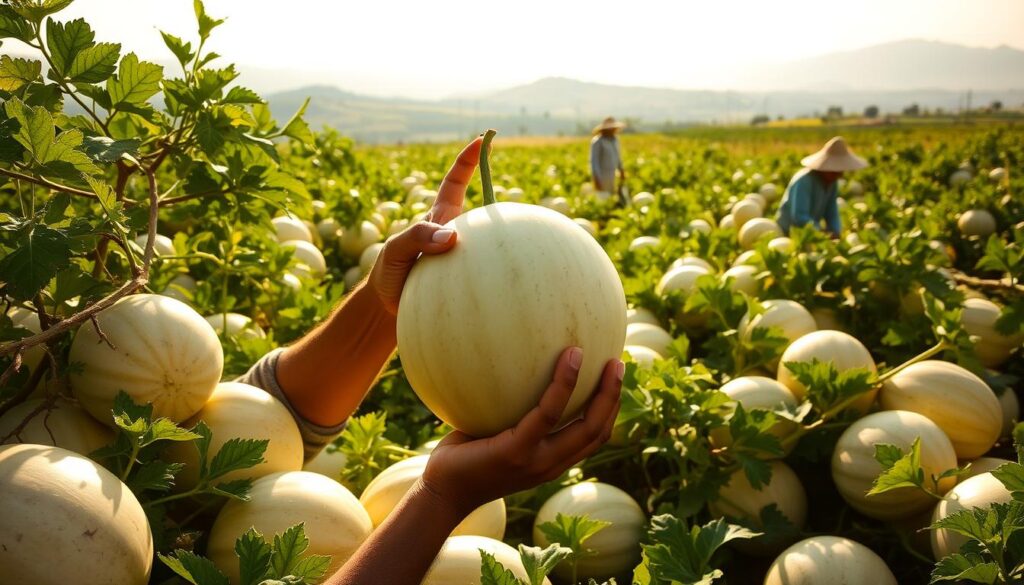
Selection and Storage Tips
To fully appreciate the flavor and texture of Casaba and Honeydew melons, it’s crucial to know how to choose and store them properly. The process begins with selecting melons that are ripe and ready to eat.
How to Choose a Ripe Casaba Melon
When selecting a Casaba melon, look for a bright yellow skin with deep furrows. The blossom end should have a slight give when pressed gently, indicating ripeness. Unlike many other melons, Casaba doesn’t emit a strong aroma when ripe, so visual cues are more important than smell when assessing ripeness.
How to Choose a Ripe Honeydew Melon
For Honeydew melons, the rind should have a creamy, slightly waxy feel rather than a matte appearance, which indicates underripeness. A ripe Honeydew will have a subtle sweet aroma at the stem end and may develop small “freckles” on its rind as it reaches peak ripeness. Both Casaba and Honeydew melons should feel heavy for their size, indicating juicy flesh inside.
Proper Storage Methods
Proper storage extends the life of these fruits. Whole, uncut melons can be kept at room temperature until ripe, then refrigerated for up to a week. Once cut, both melons should be stored in airtight containers in the refrigerator and consumed within 3-4 days for best quality. Temperature fluctuations can damage the flesh quality of both melons, so consistent refrigeration is important for cut fruit.
For longer storage, freezing is an option for both varieties. Cube the flesh and freeze on trays before transferring to freezer bags for use in smoothies or sorbets, though the texture will change significantly.
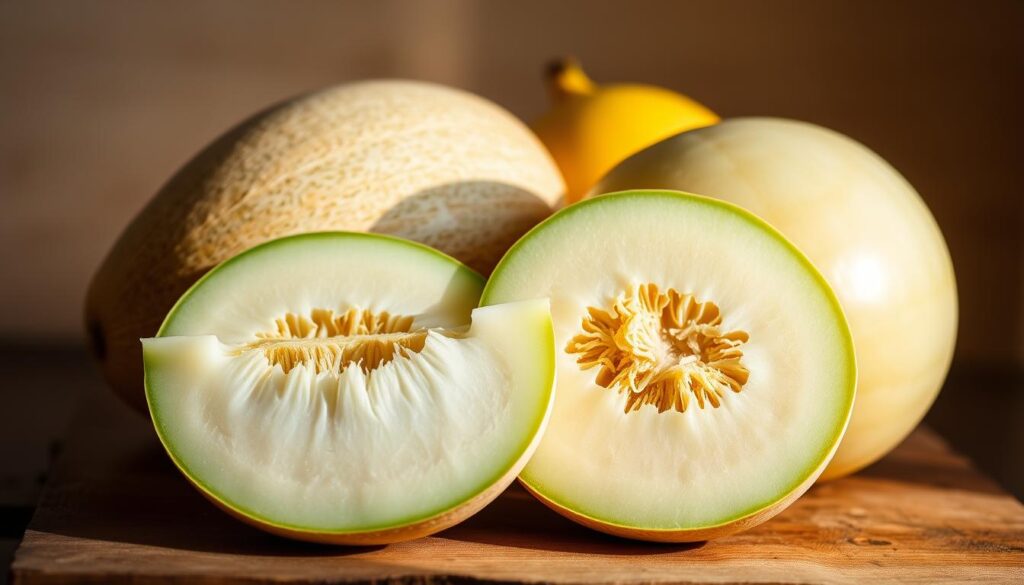
Seasonal Availability and Market Presence
Understanding the seasonal patterns of casaba and honeydew melons can help consumers make informed purchasing decisions. The availability of these melons in the market varies significantly throughout the year due to their unique growing seasons and conditions.
When to Find Casaba Melons
Casaba melons have a later and longer growing season than many other melon varieties. They typically become available from mid-summer through late fall. In North American markets, the peak casaba season runs from August through October. Although greenhouse-grown fruit may be available year-round in some regions, the flavor and quality may vary.
When to Find Honeydew Melons
Honeydew melons enjoy broader seasonal availability compared to casaba melons. The domestic peak season for honeydew melons runs from June through October in most U.S. growing regions. During the winter months, imported honeydew from Central and South American countries maintains a steady market presence in North American fruit sections.
Regional Popularity
Regional preferences for these melons vary significantly. Honeydew enjoys widespread popularity across the United States, while casaba melons have a stronger market presence in areas with Mediterranean climate and culinary influences, particularly California and parts of the Southwest. Both melons face competition from more familiar watermelon varieties during peak summer months.
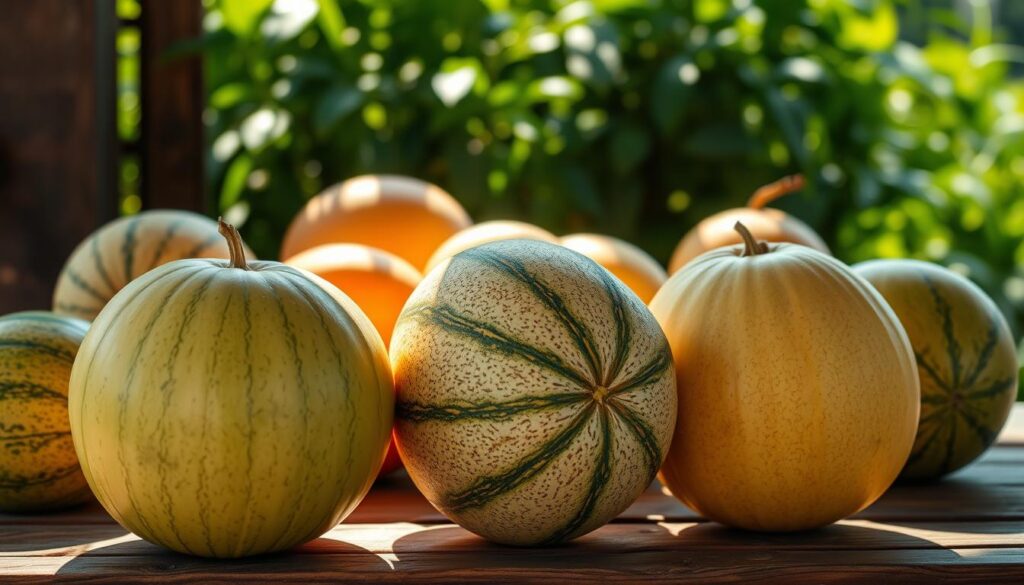
Conclusion
The distinct profiles of casaba and honeydew melons make them both valuable additions to a diverse diet. Both offer unique culinary experiences and nutritional profiles, rich in dietary fiber and various micronutrients.
Casaba melon stands out for its lower sugar content and higher protein levels, along with significant vitamin and mineral content, making it an excellent choice for those monitoring blood sugar. Its skin and rind, though different from honeydew’s, contribute to its distinct color and texture.
Honeydew excels with its juicy sweetness and versatility in both sweet and savory applications. The differences in their skin – casaba’s wrinkled yellow rind versus honeydew’s smooth pale green – make them easy to distinguish.
Both varieties offer significant dietary benefits, including hydration and fiber. Understanding their seasonal availability helps consumers make informed choices. Whether you prefer casaba’s mild notes or honeydew’s sweet profile, both are refreshing alternatives to common fruit choices, much like watermelon offers a unique experience.
